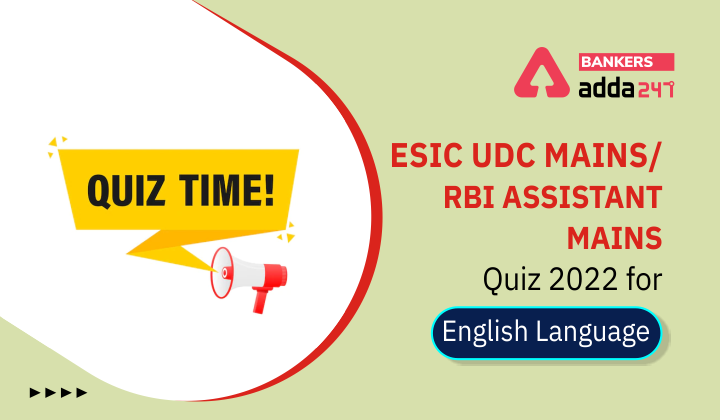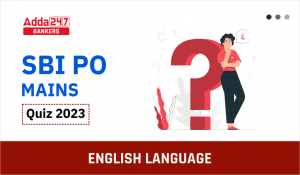
Directions (1-5): Read the following passage and answer the given questions. Some words are highlighted to help you answer the questions.
Before the invention of the World Wide Web (WWW), the earliest internet users were mainly researchers and military personnel. The network was complicated and, although it was possible to share files and messages, the interface was not user-friendly. In 1993, a researcher at CERN called Tim Berners-Lee started building a layer on top of the internet to make it easier to access, according to the World Wide Web Foundation.
Berners-Lee’s idea was to make information available as pages, written in a shared language called Hypertext Markup Language (HTML). This eventually became the World Wide Web, which is the platform used by billions of internet users around the world. After completing his first-class degree in physics at Oxford University, Berners-Lee moved on to become a scientist at CERN, the European Organization for Nuclear Research in 1989, according to the World Wide Web Consortium (W3C). That same year, Berners-Lee published a paper titled “Information Management: A Proposal”, in which he suggested the combination of hypertext and the internet for an information management system.
In this _______(I)_______ proposal for the World Wide Web, Berners-Lee described the shortcomings of the then-current system at CERN in allowing scientists access to their information and documentation. Though the internet had been around for a decade, the information had limited accessibility. Berners-Lee set out to connect both the internet and a web-structured platform to revolutionise data sharing. To achieve this, he created the Hypertext Transfer Protocol (HTTP), Uniform Resource Identifier (URI) and Hypertext Makeup Language (HTML), the building blocks for internet browsing that remain in use today, according to CERN.
Created to better serve CERN scientists and assist those across the globe with their research, Berners-Lee launched the first website, http:// info.cern.ch, in 1990. This new way to obtain information was something Berners-Lee wanted the entire world to have access to. He decided to make the World Wide Web an open and royalty- free software, allowing it to grow beyond academia.
By 1994 there were around 3,000 websites in existence, according to the World Economic Forum. After such a roaring success, Berners-Lee created W3C, a web standards organisation that also develops web specifications, guidelines, software and tools. With the continued success of the iconic ‘www.’, Berners-Lee founded the World Wide Web Foundation in 2009, an organisation working to deliver digital equality to the world.
Q1. According to the passage, what is CERN?
(a) Uniform Resource Identifier
(b) World Wide Web Consortium
(c) Hypertext Markup Language
(d) the European Organization for Nuclear Research
(e) None of these
Q2. What was the original idea which led to the conception of internet?
(a) The idea behind the development of World Wide Web was to help people in remote areas get their ideas across to each other.
(b) To make knowledge available in the form of pages written in a common language known as Hypertext Markup Language (HTML).
(c) It was invented to help the different governments of the world to collect data about their countries’ population.
(d) Both (a) and (c)
(e) All of these
Q3. Which of the following statement is incorrect in accordance to the information given in the passage?
(I) In 1994, Berners-Lee launched the World Wide Web Foundation, an organisation dedicated to achieving global digital equality.
(II) People from the military were among the first to utilise the internet.
(III) Berners-Lee established the first website to better serve CERN scientists and aid researchers all over the world with their research.
(a) Only (III)
(b) Both (I) and (III)
(c) Only (I)
(d) Only (II)
(e) All of them
Q4. Which of the following word will be placed in the blank (I)?
(a) measly
(b) strident
(c) initial
(d) avaricious
(e) None of these
Q5. Choose the synonym of TOOLS as highlighted in the passage.
(a) Altercation
(b) Nuance
(c) Retention
(d) Temperament
(e) Apparatus
Directions (6-10): Read the following passage and answer the given questions. Some words are highlighted to help you answer the questions.
Laser surgery involves the use of a laser (which stands for light amplification by stimulated emission of radiation) for a range of medical and cosmetic procedures. A laser is a source of light which can be used for a variety of applications in surgery. Light from lasers differs from that which you encounter in everyday life. Naturally occurring light from the sun, or artificial light from a lightbulb, emits a range of wavelengths of light, travelling in many different directions. However, laser light is polarized, focusing a beam in one precise location, according to Oregon State University.
Different laser wavelengths are selected based on the location and aim of a surgery. Some lasers, such as erbium lasers, are ideal for cutting body tissue, according to the British Dental Journal, but aren’t as useful for sealing torn tissue. This method, called coagulation, uses heat produced by the laser to either destroy the cells or attach two pieces of tissue together. As different wavelengths of light come into contact with different types of tissues and skin, it _______(II)_______ in different ways. Light can be reflected, scattered or absorbed by the body’s cells, while other times the laser passes right through the skin, according to the journal IEEE Transactions on Biomedical Engineering.
Chromophores, which are molecules in the body that absorb particular wavelengths, causing them to present a specific colour. These molecules absorb more of the light during laser surgery. Examples of chromophores in the human body are haemoglobin and melanin. Absorption in these areas can cause physical, chemical and temperature changes. Using lasers instead of surgical instruments has many benefits. For example, they can reduce the risk of damage to surrounding tissues, according to the IEEE Journal of Selected Topics in Quantum Electronics. After laser surgery, stitches are less likely to be needed, bleeding is reduced and the healing time for some operations is much shorter.
Laser treatment and surgery can be used either to destroy cancer cells or activate cancer drugs, according to Cancer.org. CO2 and Nd:YAG lasers are the wavelengths typically chosen to shrink tumours and are often used in endoscopes, tube-like instruments with a camera on the end that can probe deep into the body, according to the National Cancer Institute.
Q6. Erbium lasers are suitable for _____________________________________.
(a) absorbing specific wavelengths and emitting a distinct colour when exposed to them.
(b) repairing a ripped piece of tissue.
(c) for cutting human tissue.
(d) All of the above
(e) None of these
Q7. Select the benefits of laser surgery as per the information given in the passage.
(I) They have the potential to lower the danger of tissue injury in the nearby region.
(II) It can result in some surgeries having a substantially shorter recovery period.
(III) Laser surgeries can kill cancer cells or make cancer treatments work.
(a) Only (III)
(b) Only (I)
(c) Both (II) and (III)
(d) Both (I) and (II)
(e) All of the above
Q8. What is the difference between the light from lasers and natural sources of light like sunlight?
(a) Light from lasers give out a spectrum of light wavelengths that move in a variety of directions.
(b) Laser light is polarised, allowing it to focus on a single point.
(c) Light that occurs naturally glues two tissue sheets together.
(d) Both (a) and (b)
(e) Both (c) and (a)
Q9. Which of the following word will be placed in the blank (II)?
(a) responds
(b) prospers
(c) abducts
(d) secludes
(e) impeaches
Q10. Choose the antonym of SHRINK as highlighted in the passage.
(a) peruse
(b) dilate
(c) concede
(d) amok
(e) ballast
Solutions:
S1. Ans (d)
Sol. The correct answer is option (d): the European Organization for Nuclear Research.
The answer is present in the second paragraph where it is mentioned: After completing his first-class degree in physics at Oxford University, Berners-Lee moved on to become a scientist at CERN, the European Organization for Nuclear Research in 1989…….
S2. Ans (b)
Sol. The correct answer is option (b): To make knowledge available in the form of pages written in a common language known as Hypertext Markup Language (HTML).
This answer can be found in the first line of second paragraph: Berners-Lee’s idea was to make information available as pages, written in a shared language called Hypertext Markup Language (HTML).
S3. Ans (c)
Sol. The correct answer is option (c): Only (I).
This statement is incorrect because the last paragraph states: With the continued success of the iconic ‘www.’, Berners-Lee founded the World Wide Web Foundation in 2009, an organisation working to deliver digital equality to the world.
The correct information is stated in the statements (II) and (III).
Statement (II) is the first line of the passage: Before the invention of the World Wide Web (WWW), the earliest internet users were mainly researchers and military personnel.
Statement (III) is also correct because the first line of the last paragraph states: Created to better serve CERN scientists and assist those across the globe with their research, Berners-Lee launched the first website, http:// info.cern.ch, in 1990.
S4. Ans (c)
Sol. The correct answer is option (a): initial. It means of, relating to, or occurring at the beginning; first.
Avaricious- having or showing an extreme greed for wealth or material gain.
Measly- ridiculously small or few.
Strident- (of a sound) loud and harsh; grating.
S5. Ans (e)
Sol. The correct answer is option (e): apparatus. It means the technical equipment or machinery needed for a particular activity or purpose.
Altercation- a noisy argument or confrontation.
Nuance- a subtle difference in meaning.
Retention- the act of keeping something.
Temperament- usual mood or feelings.
S6. Ans (c)
Sol. The correct answer is option (c): for cutting human tissue.
The answer is in the second paragraph: Some lasers, such as erbium lasers, are ideal for cutting body tissue, according to the British Dental Journal, ……………….
S7. Ans (e)
Sol. The correct answer is option (e): All of the above.
All of the given statements mention the advantages and can be found in the third and fourth paragraphs.
Third paragraph:
Statement (I): For example, they can reduce the risk of damage to surrounding tissues, …..
Statement (II): After laser surgery, stitches are less likely to be needed, bleeding is reduced and the healing time for some operations is much shorter.
Fourth paragraph:
Statement (III): Laser treatment and surgery can be used either to destroy cancer cells or activate cancer drugs, according to Cancer.org.
S8. Ans (b)
Sol. The correct answer is option (b): Laser light is polarised, allowing it to focus on a single point.
The answer exists in the first paragraph where it says: Naturally occurring light from the sun, or artificial light from a lightbulb, emits a range of wavelengths of light, travelling in many different directions. However, laser light is polarized, focusing a beam in one precise location, according to Oregon State University.
Rest of the statements are incorrect.
S9. Ans (a)
Sol. The correct answer is option (a): responds. It means to say or do something as a reaction to something that has been said or done
Prospers- succeed in material terms; be financially successful.
Abducts- take (someone) away illegally by force or deception; kidnap.
Secludes- keep (someone) away from other people.
Impeaches- call into question the integrity or validity of (a practice).
S10. Ans (b)
Sol. The correct answer is option (b): dilate. It means make or become wider, larger, or more open.
Amok- behave in an out-of-control fashion.
Peruse- read (something), typically in a thorough or careful way.
Concede- admit or agree that something is true after first denying or resisting it; surrender or yield (a possession, right, or privilege).
Ballast- give stability to (a ship) by putting a heavy substance in its bilge.




 English Quizzes For SBI PO Mains 2023 - ...
English Quizzes For SBI PO Mains 2023 - ...








